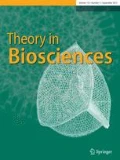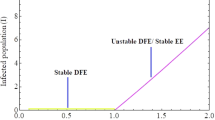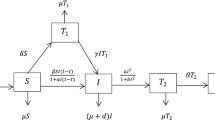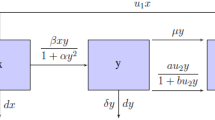Abstract
In the present article, the dynamics of a novel combination of ratio-dependent incidence rate and saturated treatment rate in susceptible-infected-recovered disease compartmental model has been presented. The ratio-dependent incidence rate has been incorporated into the model to monitor the situation when ratio of the number of infectives to that of the susceptibles is getting higher. The saturated treatment rate of the infected population has been considered as Holling type II functional, which explains the limitation in treatment availability. From the mathematical analysis of the model, two types of equilibria of the model have been obtained, which are named as disease-free equilibrium (DFE) and endemic equilibrium (EE). The local stability behavior of equilibria has been investigated by the basic reproduction number \( \left( {R_{0} } \right) \), center manifold theory and Routh–Hurwitz criterion. It has been investigated that the DFE is locally asymptotically stable when \( R_{0} < 1 \), and when \( R_{0} = 1 \), the DFE exhibits either a forward bifurcation or a backward bifurcation under some conditions. The local stability behavior of the EE has also been analyzed, and some conditions are obtained for the same. Finally, some numerical computations have been performed in support of our theoretical results.








Similar content being viewed by others
References
Alexander ME, Bowman C, Moghadas SM, Summers R, Gumel AB, Sahai BM (2004) A vaccination model for transmission dynamics of influenza. SIAM J Appl Dyn Syst 3(4):503–524
Capasso V, Serio G (1978) A generalization of the Kermack–McKendrick deterministic epidemic model. Math Biosci 42(1–2):43–61
Chavez CC, Song B (2004) Dynamical models of tuberculosis and their applications. Math Biosci Eng 1:361–404
Driessche PVD, Watmough J (2002) Reproduction numbers and sub-threshold endemic equilibria for compartment models of disease transmission. Math Biosci 180:29–48
Dubey B, Patra A, Srivastava PK, Dubey US (2013) Modelling and analysis of a SEIR model with different types of nonlinear treatment rates. J Biol Syst 21(3):1350023
Dubey B, Dubey P, Dubey US (2015) Dynamics of an SIR model with nonlinear incidence and treatment rate. Appl Appl Math 10(2):718–737
Dubey P, Dubey B, Dubey US (2016) An SIR model with nonlinear incidence rate and Holling type III treatment rate. Appl Anal Biol Phys Sci 186:63–81
Goel K, Nilam (2019) A mathematical and numerical study of a SIR epidemic model with time delay, nonlinear incidence and treatment rates. Theory Biosci. https://doi.org/10.1007/s12064-019-00275-5
Huang G, Takeuchi Y, Ma W, Wei D (2010) Global Stability for delay SIR and SEIR epidemic models with nonlinear incidence rate. Bull Math Biol 72:1192–1207
Kermack WO, McKendrick AG (1927) A contribution to the mathematical theory of Epidemics. Proc R Soc Lond A 115(772):700–721
Kumar A, Nilam (2019a) Dynamic behavior of a SIR epidemic model along with Time delay. Crowley–Martin type incidence rate and Holling type II treatment rate. Int J Nonlinear Sci Numer Simul. https://doi.org/10.1515/ijnsns-2018-0208
Kumar A, Nilam (2019b) Stability of a delayed SIR epidemic model by introducing two explicit treatment classes along with nonlinear incidence rate and Holling type treatment. Comput Appl Math 38:130
Kumar A, Goel K, Nilam (2019) A deterministic time-delayed sir epidemic model: mathematical modeling and analysis. Theory Biosci. https://doi.org/10.1007/s12064-019-00300-7
Li GH, Zhang YX (2017) Dynamic behavior of a modified SIR model in epidemic diseases using nonlinear incidence and recovery rates. PLoS ONE 12(4):e0175789
Li B, Yuan S, Zhang W (2011) Analysis on an epidemic model with a ratio-dependent nonlinear incidence rate. Int J Biomath 4(2):227–239
Liu WM, Levin SA, Iwasa Y (1986) Influence of nonlinear incidence rates upon the behavior of SIRS epidemiological models. J Math Biol 23(2):187–204
Sastry S (1999) Analysis, stability and control. Springer, New York
Wang WD (2002) Global behavior of an SEIRS epidemic model with time delays. Appl Math Lett 15:423–428
Wang X (2004) A simple proof of Descartes’s rule of signs. Am Math Mon. https://doi.org/10.2307/4145072
Xu R, Ma Z (2009) Stability of a delayed SIRS epidemic model with a nonlinear incidence rate. Chaos Solut Fractals 41:2319–2325
Zhou L, Fan M (2012) Dynamics of a SIR epidemic model with limited medical resources revisited. Nonlinear Anal RWA 13:312–324
Acknowledgements
The authors are thankful to Delhi Technological University, Delhi, India, for monetary support for this research.
Author information
Authors and Affiliations
Corresponding author
Ethics declarations
Conflict of interest
The authors declare that they have no conflict of interest.
Additional information
Publisher's Note
Springer Nature remains neutral with regard to jurisdictional claims in published maps and institutional affiliations.
Rights and permissions
About this article
Cite this article
Kumar, A., Kumar, M. & Nilam A study on the stability behavior of an epidemic model with ratio-dependent incidence and saturated treatment. Theory Biosci. 139, 225–234 (2020). https://doi.org/10.1007/s12064-020-00314-6
Received:
Accepted:
Published:
Issue Date:
DOI: https://doi.org/10.1007/s12064-020-00314-6




